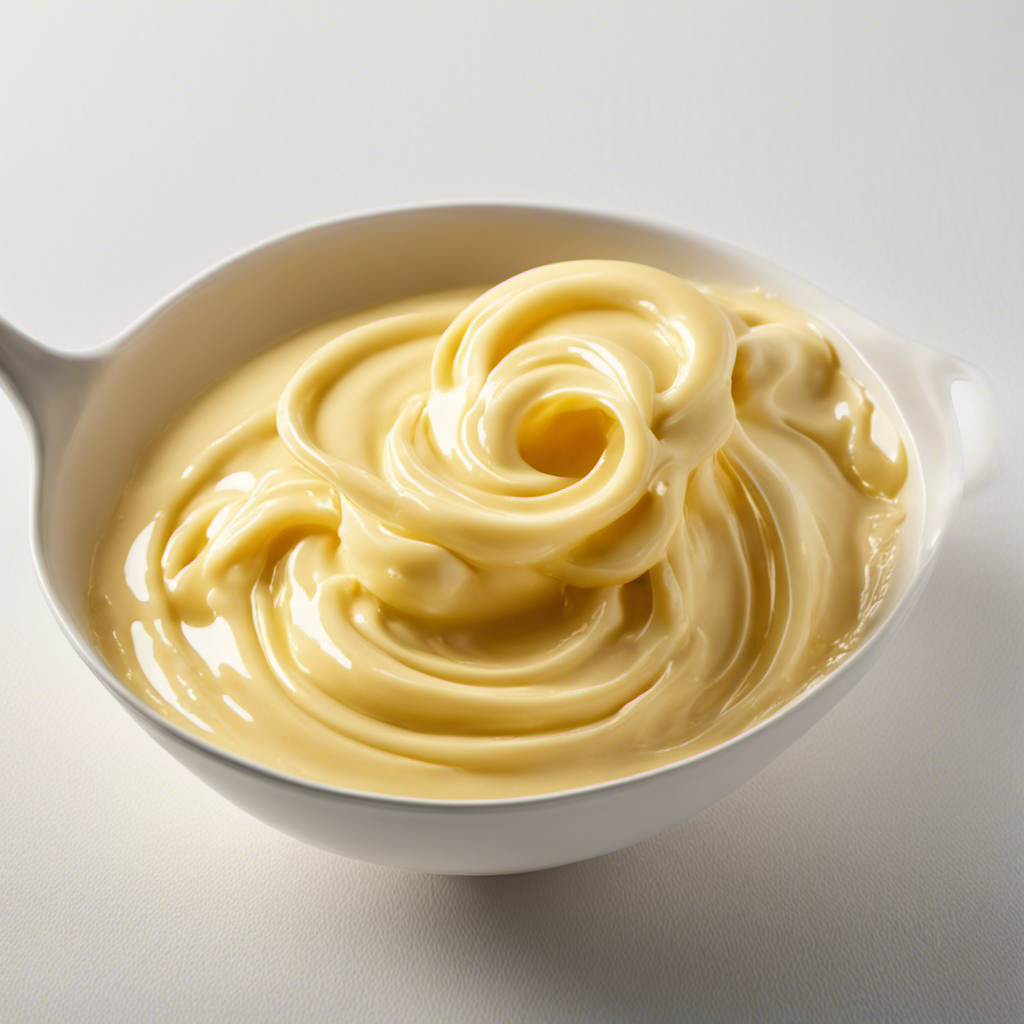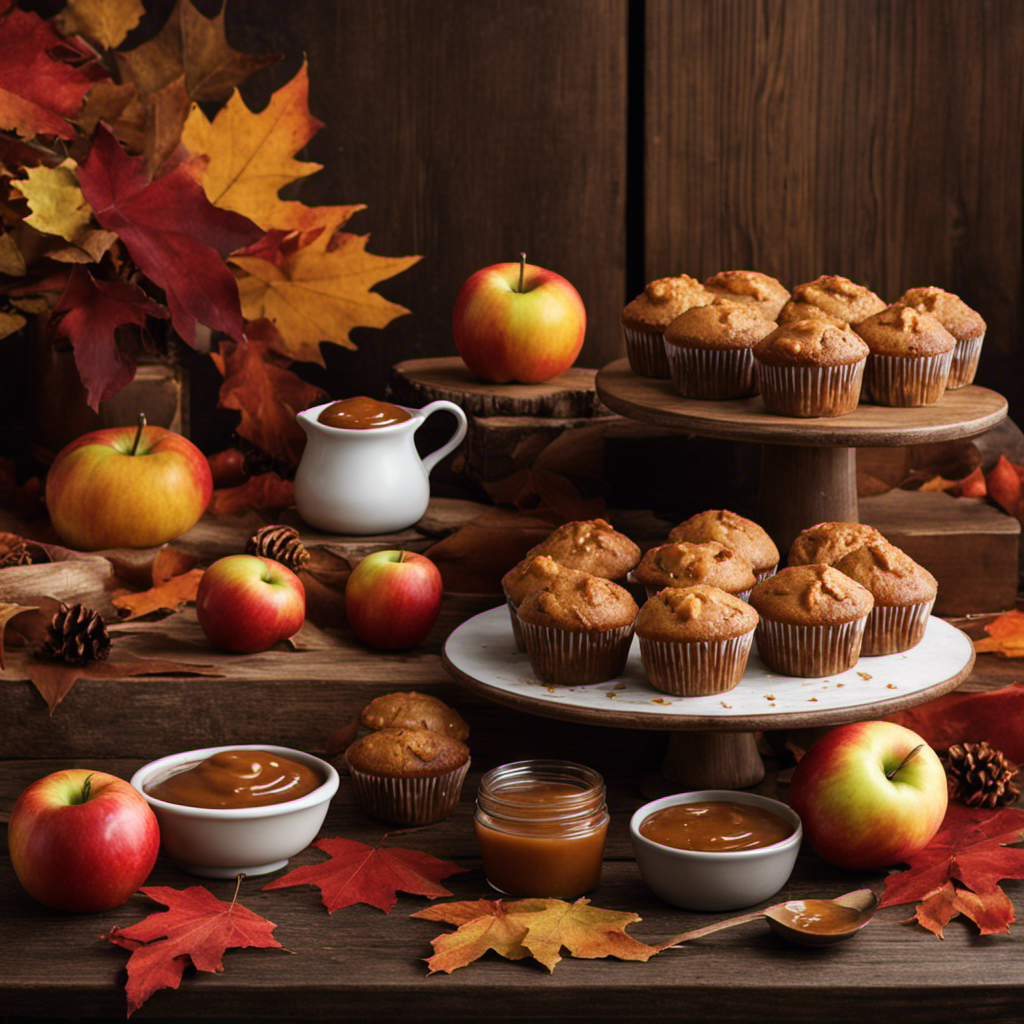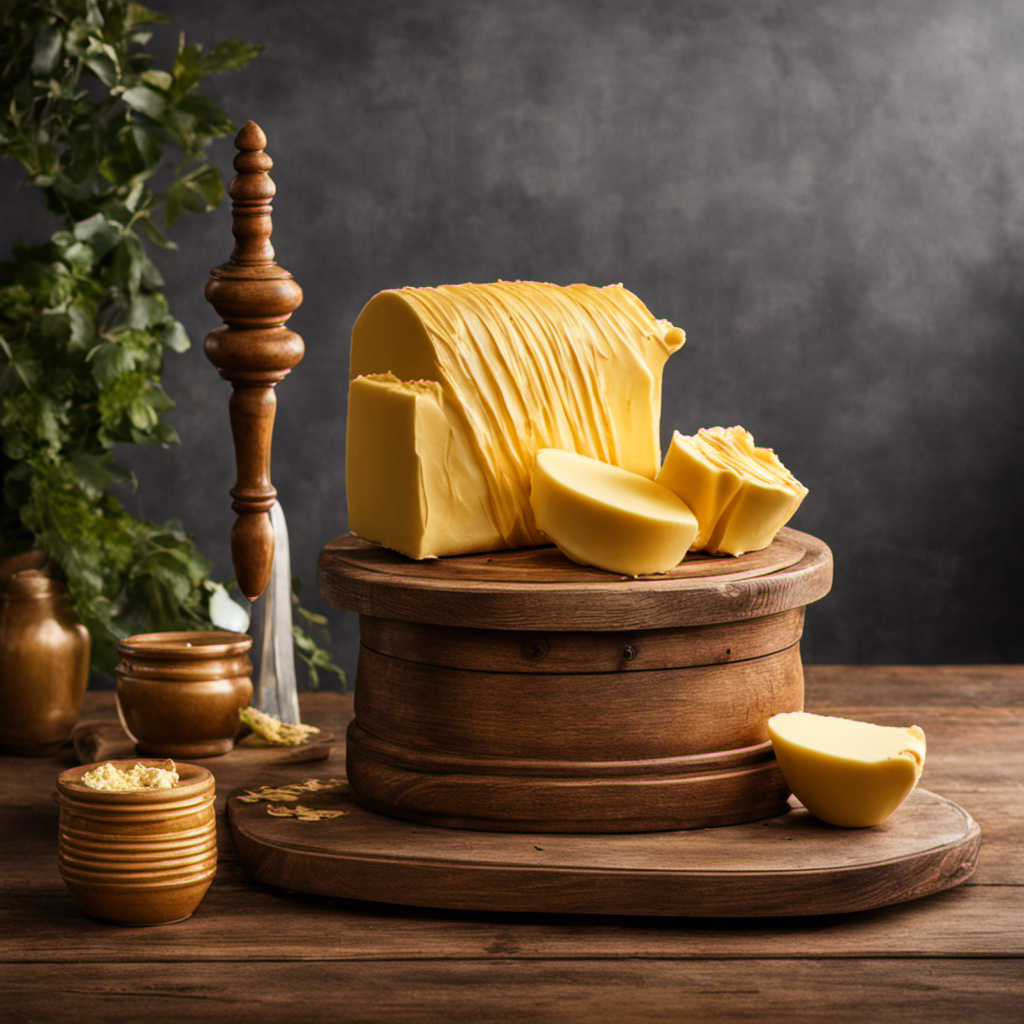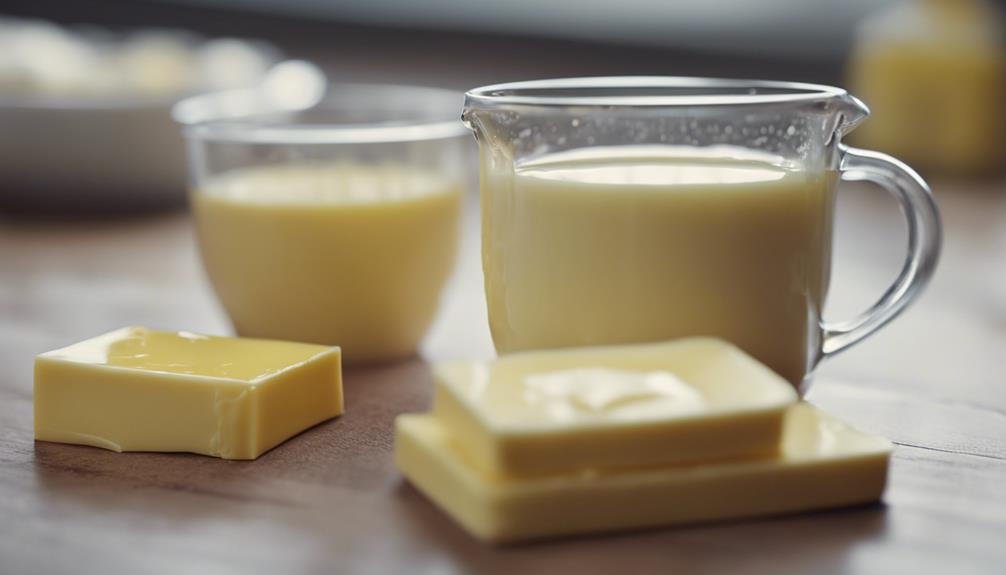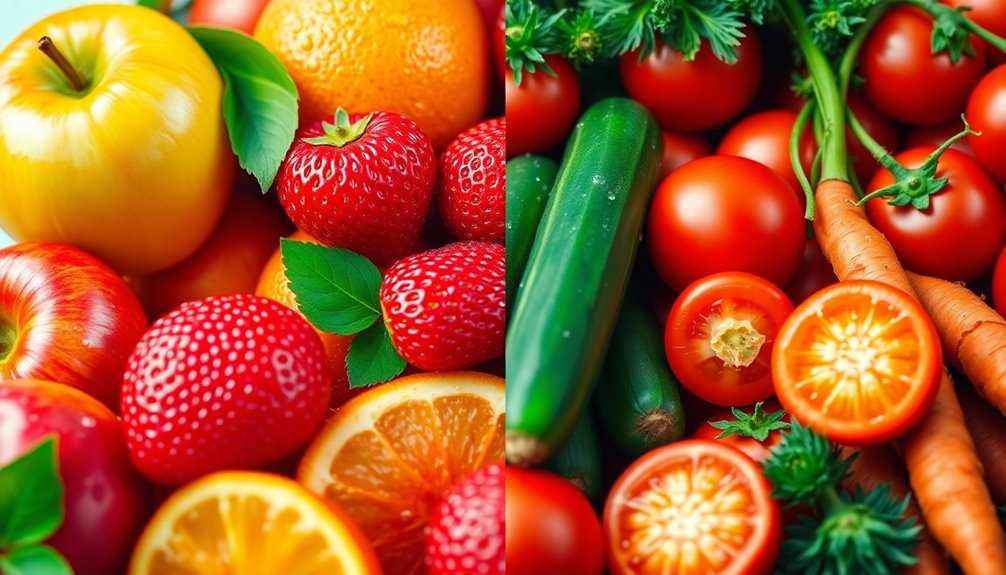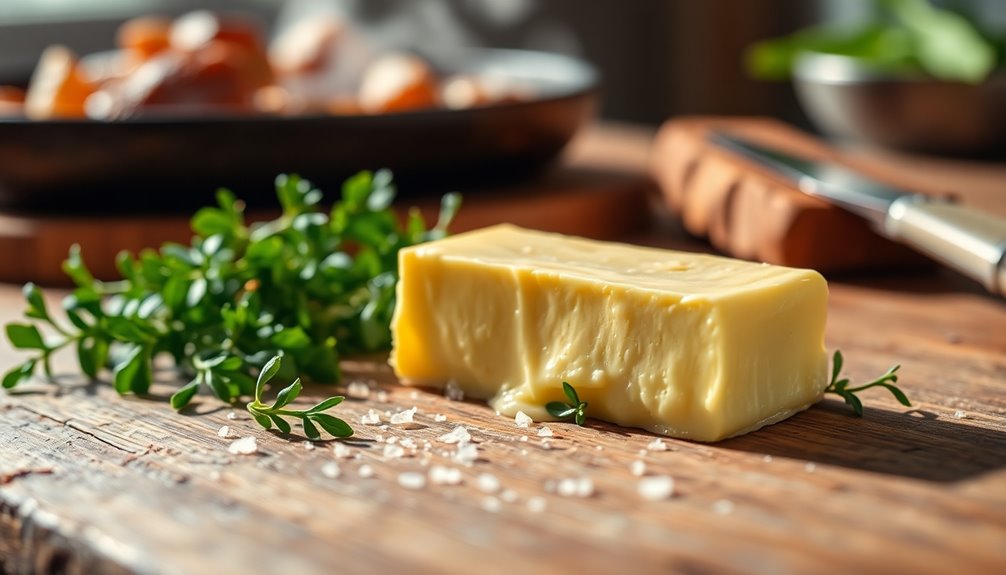I have always been fascinated by the complex details of everyday materials as a science enthusiast.
Did you know that butter, a staple in many kitchens, is not as simple as it seems? In fact, it is a unique mixture with distinct properties.
In this article, I will delve into the question of what type of mixture butter truly is, exploring its composition, classification, and the science behind its formation.
Get ready to uncover the scientific wonders hidden within this delicious spread.
Key Takeaways
- Butter is a homogeneous mixture made up of water, milk fat, and milk proteins.
- It also has a heterogeneous nature, with distinct phases of fat and water observed within a stick of butter.
- The primary components of butter include water (15-20%), milk fat (around 80%), and milk solids (proteins, lactose, and minerals).
- Butter is an oil-in-water emulsion, with tiny water droplets dispersed in a continuous phase of fat, and its stability and texture are influenced by the butterfat content.
Butter as a Homogeneous Mixture
Butter is a homogeneous mixture because it is evenly blended. Its consistency is smooth and creamy, with a rich and luxurious texture. It is composed of water, milk fat, and milk proteins, which are uniformly distributed throughout the mixture.
The water component contributes to the moisture content of butter, giving it a moist, spreadable texture. The milk fat provides the smoothness and richness that we associate with butter, while the milk proteins add structure and contribute to its creamy mouthfeel.
When butter is made, the milk fat globules are broken down and dispersed throughout the mixture, resulting in a consistent and uniform product. This uniformity in composition and texture makes butter a prime example of a homogeneous mixture.
Butter as a Heterogeneous Mixture
To understand how butter is classified as a heterogeneous mixture, you can observe its composition closely. Butter’s consistency is a key characteristic that indicates its heterogeneous nature. When you examine a stick of butter, you can notice distinct phases within it. These phases are responsible for the separation in butter, which can be observed under certain conditions.
Here is a closer look at the composition of butter:
-
The fat phase: This is the main component of butter and gives it its smooth and creamy texture. It is composed of tiny fat globules, which are dispersed throughout the butter.
-
Water phase: This phase consists of water droplets that are scattered within the fat phase. The water content in butter is usually around 15-20%.
The Composition of Butter
When examining the composition of butter, we can observe distinct phases and their arrangement within the mixture.
Butter is primarily composed of water, milk fat, and milk solids. The water content in butter ranges from 15-20%, while the fat content is typically around 80%. The milk solids in butter consist of proteins, lactose, and minerals.
These components are dispersed throughout the butter in a semi-solid emulsion. The fat globules are suspended in the water phase, forming a continuous network. This arrangement gives butter its characteristic smooth texture and creamy consistency.
During the churning process, the fat globules collide and aggregate, creating the buttery texture we are familiar with.
Understanding the composition of butter is essential for various culinary and industrial applications.
Factors Affecting Butter’s Mixture Properties
The fat content in butter affects its texture and consistency. Butter is an emulsion, consisting of water and fat globules suspended in a continuous phase. Several factors influence the texture of butter:
- Fat content: Higher fat content leads to a smoother and creamier texture.
- Churning process: The duration and speed of churning affect the size and distribution of fat globules, which in turn impact the texture.
- Temperature: Churning at colder temperatures can result in smaller fat globules and a firmer texture.
- Agitation: More vigorous churning can lead to more evenly distributed fat globules, resulting in a smoother and softer texture.
Understanding butter’s stability is crucial in predicting its texture over time. Factors influencing stability include:
- Temperature: Butter’s texture changes with temperature fluctuations, with colder temperatures hardening the fat and warmer temperatures softening it.
- Storage conditions: Exposure to air, light, and moisture can affect butter’s stability, leading to rancidity or spoilage.
Understanding the Emulsion in Butter
Understanding the emulsion in butter helps determine its texture and stability.
Butter is an oil-in-water emulsion, meaning that it consists of tiny droplets of water dispersed in a continuous phase of fat.
The stability of this emulsion is crucial in maintaining the desired properties of butter.
One key factor that affects emulsion stability is the butterfat content.
Higher butterfat content results in a more stable emulsion, as the fat molecules form a continuous phase that surrounds and stabilizes the water droplets.
This helps prevent the separation of water and fat, giving butter its smooth and creamy texture.
Additionally, the butterfat content also affects the flavor and mouthfeel of butter, contributing to its rich and indulgent taste.
Understanding the emulsion and its stability is essential in producing high-quality butter products.
Butter’s Mixture Classification
Butter can be classified based on the type of mixture it is. There are two main classifications of butter: water-in-oil emulsion and oil-in-water emulsion.
-
Water-in-oil emulsion:
This type of butter has a higher fat content and a creamy texture. The fat globules are dispersed throughout the water phase, giving it a smooth and spreadable consistency. Water-in-oil emulsion butter is commonly used for baking and cooking due to its ability to retain moisture and enhance flavor. -
Oil-in-water emulsion:
This type of butter has a lower fat content and a softer texture. The water phase is dispersed throughout the fat phase, resulting in a more solid consistency. Oil-in-water emulsion butter is often used for spreading on bread or toast, as it is easier to spread and melts quickly.
Understanding the classification of butter is essential when analyzing its physical properties, such as its texture and nutritional value.
Analyzing Butter’s Physical Properties
When analyzing butter’s physical properties, it’s important to consider factors such as texture and nutritional value.
Butter’s melting point is a critical aspect to understand its behavior when exposed to heat. The melting point of butter is typically around 32-35 degrees Celsius, which makes it solid at room temperature but easily spreadable when heated.
Texture analysis reveals that butter has a smooth and creamy consistency due to its high fat content. It is composed of water, milk solids, and fat globules, which contribute to its unique texture.
Understanding these physical properties is crucial in comprehending the science behind butter’s mixture formation, as it involves the emulsion of fat and water.
The Science Behind Butter’s Mixture Formation
In understanding the science behind butter’s mixture formation, it is essential to discuss the emulsion process and the role of fat globules.
The emulsion process refers to the method by which the water and fat components of butter are combined to form a stable mixture. This process involves the dispersion of fat globules throughout the water matrix, creating a uniform and creamy texture.
Butter’s Emulsion Process
The emulsion process of butter involves the blending of milk and cream. This process is crucial for the formation of a stable emulsion, which is an essential characteristic of butter.
To understand the emulsion stability in butter manufacturing process, it is important to consider the following:
-
Emulsifiers: These are compounds that help stabilize the emulsion by reducing the surface tension between the milk and cream components. Common emulsifiers used in butter production include lecithin and mono- and diglycerides.
-
Churning: The emulsion is further stabilized through the churning process, which involves mechanical agitation to break down the fat globules and encourage the formation of a stable butter emulsion.
The emulsion process is just the beginning when it comes to understanding the characteristics of butter. Now, let’s explore the role of fat globules in the formation and texture of butter.
Role of Fat Globules
To understand how fat globules contribute to the formation and texture of butter, it’s important to consider their size and distribution throughout the emulsion. Fat globules play a crucial role in the overall structure of butter. These globules are dispersed in the water phase of the emulsion, creating a stable and creamy texture.
The size of the fat globules influences the mouthfeel and spreadability of butter. Smaller fat globules result in a smoother texture, while larger ones give a more grainy texture. The distribution of fat globules affects the consistency of butter, as the more evenly dispersed they are, the smoother and more spreadable the butter will be.
Emulsion formation is dependent on the stability of the fat globules, which are surrounded by a membrane of phospholipids and proteins. Understanding the role of fat globules in butter formation is essential for achieving the desired texture and quality.
Frequently Asked Questions
Is Butter Considered a Dairy Product?
Yes, butter is considered a dairy product. It is made from the fat of milk and is not vegan. Additionally, butter is a processed food as it undergoes churning and may contain additives.
Can Butter Be Considered a Solid or a Liquid?
Butter can be categorized as a semi-solid mixture due to its physical properties. It exhibits characteristics of both a solid and a liquid, making it pliable yet retaining its shape.
What Are the Different Types of Butter Available in the Market?
There are various flavors of butter available in the market, each with its unique taste profile. Butter is used in cooking, baking, and as a spread. It is a versatile ingredient that enhances the flavor of dishes.
How Does the Process of Churning Affect the Mixture Properties of Butter?
Churning affects the texture of butter by breaking down the fat globules and incorporating air, resulting in a smoother and lighter consistency. It also alters the composition, increasing the water content and reducing the milk solids.
Are There Any Health Benefits Associated With Consuming Butter?
There are health benefits associated with consuming butter. However, the impact of butter on cholesterol levels should be considered. Consuming excessive amounts of butter may lead to elevated cholesterol levels, increasing the risk of heart disease.
Conclusion
In conclusion, after analyzing the composition and physical properties of butter, it can be classified as a heterogeneous mixture. Its mixture formation is primarily due to the emulsion of fat, water, and milk solids.
Factors such as temperature and agitation play a significant role in the stability of the mixture. Butter’s unique blend of ingredients creates a creamy texture that melts in your mouth like a dream.
So, next time you spread butter on your toast, savor the delightful symphony of flavors in this scientific marvel.
